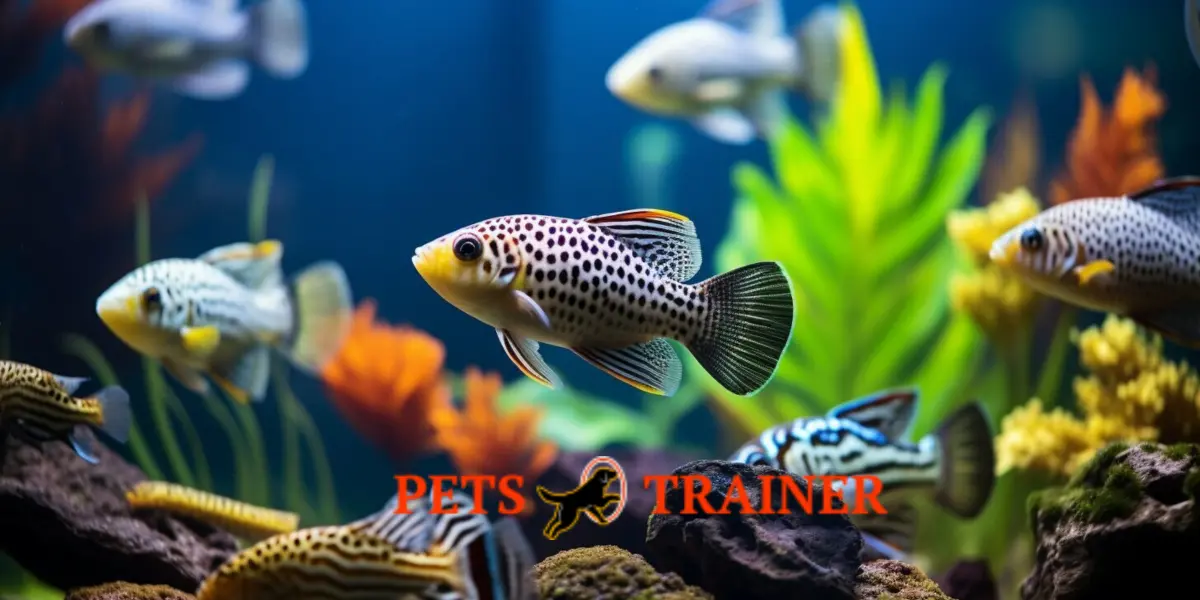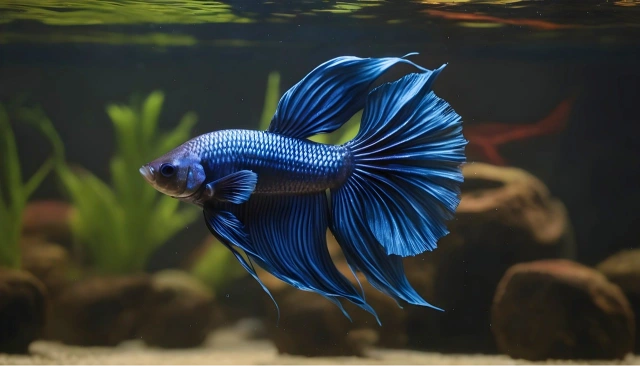Table of Contents
ToggleAre you tired of watching your fish swim aimlessly around their tank, showing no signs of interest or engagement? If so, it’s time to delve into the fascinating world of fish behavior modification. In this article, I will explore innovative and practical tips for modifying fish behavior and transforming your aquarium into a dynamic and captivating underwater world.
From understanding the psychology of fish to implementing enriching activities, I will uncover the secrets to keeping your aquatic pets happy and stimulated.
Tips for a Happy and Healthy Aquarium
Tank Size and Layout
When it comes to creating the perfect tank size and layout for your fish, it’s important to consider their natural behavior. Providing ample space and an engaging layout can encourage natural behaviors and reduce stress in your fish. Consider opting for a larger tank to allow for more swimming space, which can also help minimize aggressive behavior among multiple fish species.
In terms of layout, incorporating plenty of plants and hiding spots can create a more dynamic environment for your fish. Not only does this mimic their natural habitat, but it also provides opportunities for exploration and mental stimulation. Additionally, arranging the decor in a way that allows for clear swimming paths and designated territories can help maintain a harmonious environment within the tank.
By paying attention to these details in tank size and layout, you have the potential to impact the behavior of your aquatic pets positively. With thoughtful consideration of their needs and instincts, you can create an enriching environment that promotes natural behaviors while fostering a healthy balance within the tank community.
Water Quality
Water quality is often overlooked when it comes to managing fish behavior, but it plays a critical role in their wellbeing. Poor water quality can lead to stress, reduced immune function, and behavioral changes in fish. To ensure optimal water quality for your aquatic friends, regular monitoring and maintenance of pH levels, ammonia, nitrite, and nitrate levels are essential.
Additionally, investing in a good filtration system and conducting regular water changes can help maintain a healthy aquatic environment. In addition to basic water quality management, considering the impact of temperature fluctuations on fish behavior is crucial.
Sudden temperature changes can significantly stress fish and alter their behavior. A stable temperature is vital for maintaining the overall health and behavior of fish. By understanding the intimate relationship between water quality and fish behavior, aquarists can create an optimal environment for their beloved finned companions while minimizing stress-related behavioral modifications.
Temperature Control
Maintaining the right temperature in your fish tank is crucial for the health and behavior of your aquatic friends. It’s well-known that fish are ectothermic, meaning their body temperature is regulated by their environment. However, what is often overlooked is the impact of subtle temperature changes on their behavior. By carefully controlling the temperature, you can encourage specific behaviors in your fish.
For example, a slightly lower temperature can promote slower movements and calmer behavior, which could be beneficial during breeding or acclimatization periods. Conversely, slightly higher temperatures can incite more active swimming and feeding behaviors. Furthermore, when adjusting the temperature to influence fish behavior, it’s important to consider species-specific preferences and natural habitats.
Mimicking these conditions as closely as possible can have a profound effect on their overall wellbeing and interactions with other tank inhabitants. Additionally, using gradual changes in temperature rather than abrupt shifts can help minimize stress and ensure a smooth transition for your finned companions.
With careful attention to temperature control and an understanding of its impact on fish behavior, enthusiasts can create more harmonious aquarium environments that cater to the instincts and preferences of different species.
Lighting
Creating the ideal lighting environment for your aquarium can have a significant impact on the behavior of your fish. Adjusting the intensity and color temperature of the light can simulate natural conditions, influencing feeding patterns, social interactions, and breeding behaviors.
For instance, using warmer, red-toned lights during sunset and sunrise can help mimic dawn and dusk in nature, encouraging fish to become more active during these times. Additionally, experimenting with blue-toned lights to replicate moonlight can provide a calming effect that mirrors the natural rhythm of a full day.
Moreover, varying the intensity of light throughout the day can mimic fluctuating weather conditions and trigger natural behaviors in fish, such as hunting or hiding. Implementing gradual changes in brightness levels throughout daylight hours can support your fish’s circadian rhythm, promoting overall wellbeing and reducing stress.
Feeding Routine
Feeding routine plays a crucial role in shaping the behavior of fish in an aquarium. By establishing a consistent feeding schedule, you can condition your fish to recognize certain times for food, which can help reduce aggression and competition during feeding. One effective strategy is to create a regular feeding pattern, such as twice a day at specific times, and stick to it.
This helps fish learn when to expect food, leading to reduced stress and improved overall wellbeing. In addition to timing, the method of food distribution can also impact fish behavior. For instance, using automatic feeders or placing food in different parts of the tank encourages natural foraging behaviors and minimizes aggressive competition for food.
Furthermore, varying the type and texture of the diet keeps fish mentally stimulated and reduces boredom-induced aggression. Overall, a thoughtful approach to feeding routines not only maintains healthy appetites but also fosters positive behavioral changes in aquarium inhabitants.
Social Dynamics
Social dynamics play a crucial role in the behavior of all living organisms, including fish. Fish exhibit fascinating social interactions within their communities, with various species showcasing unique hierarchies and communication methods. Understanding these social dynamics is essential for those who keep fish as pets or study them in their natural habitat.
In the realm of fish behavior modification, it’s important to consider the social structure within a tank or aquarium. Introducing new fish can disrupt the established hierarchy and lead to stress and aggression among existing inhabitants. Careful observation and strategic planning are necessary to maintain harmonious social dynamics within the tank.
Furthermore, considering the individual personalities and temperaments of different fish species is vital when attempting to modify their behavior. Just like humans, each fish has its preferences and tendencies. By recognizing these nuances and catering to their specific needs, it becomes possible to influence their behaviors effectively while maintaining a healthy social balance within the aquatic community.
Enrichment Activities
Enrichment activities are not just for land-based pets; they are also crucial for fish to thrive in their environment. Consider incorporating live plants into your aquarium setup to provide hiding spots and stimulate natural behaviors. Introducing floating toys or mirrors can also pique a fish’s curiosity and encourage physical activity.
Moreover, rotating different types of food or using puzzle feeders can engage their minds and prevent boredom. It’s important to remember that each fish species has unique enrichment needs, so it’s essential to research the specific requirements of your fish. Understanding their natural behaviors and habitats will guide you in creating a stimulating environment for your underwater friends.
Additionally, observing changes in behavior after implementing new enrichment activities can be rewarding and help strengthen the bond between you and your friends. Incorporating enrichment activities is not only beneficial for the overall wellbeing of your fish but also provides an opportunity for you as a pet owner to learn more about the fascinating world beneath the water’s surface.
Observation and Monitoring
Observation and monitoring are crucial components of successful fish behavior modification. By carefully observing their behavior patterns and interactions within the environment, fish owners can gain valuable insights into their needs and preferences. This firsthand knowledge allows for targeted interventions that can effectively positively modify fish behavior.
Furthermore, continuous monitoring of fish behavior enables owners to detect any signs of stress or discomfort early on, allowing for prompt intervention. In addition, tracking changes in behavior over time provides valuable data that can be used to optimize the overall wellbeing of the aquatic ecosystem.
Ultimately, by leveraging observation and monitoring as key tools in fish care, owners can cultivate an environment that promotes healthy and natural behaviors among their aquatic companions.
By combining keen observation with consistent monitoring, fish enthusiasts can uncover new strategies for enhancing the wellbeing of their underwater friends. This approach fosters a deeper understanding of the intricate dynamics at play within the aquarium ecosystem and empowers owners to make informed decisions that positively impact fish behavior.
Conclusion
In conclusion, understanding fish behavior and the factors that influence it is crucial for successful fishkeeping. By implementing the tips and techniques discussed in this article, fish owners can effectively modify their fish’s behavior to create a healthier and more harmonious aquarium environment.
Whether it’s providing appropriate tank conditions, introducing compatible tank mates, or utilizing positive reinforcement techniques, there are various ways to impact fish behavior positively.
It is important to approach behavior modification with patience and consistency, as changes may take time to become noticeable. By applying these methods thoughtfully and responsibly, fish owners can enhance their understanding of their aquatic pets and promote their wellbeing.
FAQs
1. Q: How can I stop my fish from being aggressive towards other tank mates?
A: Gradually introduce new tank mates and provide plenty of hiding spots to reduce aggression.
2. Q: What can I do to encourage my fish to eat more in a community tank?
A: Offer a variety of foods and ensure all tank mates have access to food during feeding times.
3. Q: How can I teach my fish to perform tricks or tasks?
A: Use positive reinforcement techniques such as clicker training and reward-based learning.
4. Q: My fish is always hiding; how can I make it more active?
A: Provide stimulating environments with plants, ornaments, and regular changes in tank layout.
5. Q: Is it possible to train my fish to come to the surface for feeding?
A: Yes, you can condition your fish by using consistent feeding times and tapping on the tank before feeding.

Dr. Usman Bajwa, a dedicated veterinarian with a passion for pets, brings years of expertise to the world of pet grooming. Through his blog, he shares valuable insights and practical tips to help pet owners provide the best care for their furry companions. With a focus on promoting the health and happiness of pets, Dr. Usman articles offer easy-to-follow guidance on grooming techniques. When he’s not writing, you can find him at his clinic or enjoying time with his own beloved pets.




